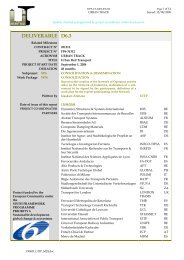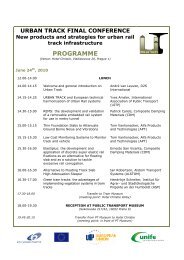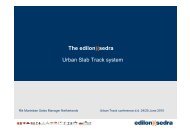DELIVERABLE 2.8 - urban track
DELIVERABLE 2.8 - urban track
DELIVERABLE 2.8 - urban track
Create successful ePaper yourself
Turn your PDF publications into a flip-book with our unique Google optimized e-Paper software.
3.4. MEASUREMENTS<br />
D0208_STIB_M24.doc<br />
TIP5-CT-2006-031312 Page 36 of 44<br />
URBAN TRACK Issued: August 13, 2008<br />
Quality checked and approved by project co-ordinator André Van Leuven<br />
The verification of the advantages of modern <strong>track</strong> alignment design compared to conventional one is<br />
done by measurement of accelerations at the metro train of Wiener Linien. The main task is to find the<br />
influence of <strong>track</strong> alignment design by measurement of the accelerations at the vehicle. The<br />
measurements were done with extremely sensitive, low frequency, accelerometers (applied sub critical,<br />
displacement s = F/c = - a/�0², �0 = 2(((f0 characteristic frequency). The first test-measurement with 8<br />
channels was realized one morning and followed by the main-measurement of the <strong>track</strong> geometry with<br />
up to 18 channels in 3 nights during pause of normal operation. The measurement of the whole metro<br />
net with 20 channels each line was realized twice in two days during normal operation with high<br />
frequency sensors in up-direction at the axle bearings.<br />
Accelerometers were mounted on the axle bearings in transverse (low frequency) and vertical (middle<br />
frequency for ripple) direction, in the middle of the bogies, at the bottom of the vehicle’s body in<br />
longitudinal, transverse (triaxial) and vertical direction over both bogies and in the middle, at the left and<br />
right outer walls in vertical direction and beneath the roof in transverse direction approximately over<br />
both bogies.<br />
Marker equipment with inductive approach switch for the exact spatial determination of the vehicle’s<br />
position was used. Therefore, mean values could be taken for different runs at the same position. A<br />
series of measurement runs were performed at the night both in travelling and in reverse direction and at<br />
different speeds.<br />
The procedure for three test-curves at the metro U4 was the following:<br />
Production of the ideal old conventional geometry with clothoid and constant cant gradient.<br />
Measurement of accelerations with measurement train.<br />
Re-tamping to Viennese transition curve and cant gradient.<br />
Measurement of accelerations with measurement train.<br />
Evaluation of the actual accelerations relative to the nominal accelerations (maximal 0,654 m/s²).<br />
Calculations of the dispersions = SQRT(variances) of the mean accelerations within the vehicle’s body<br />
in [m/s²].








